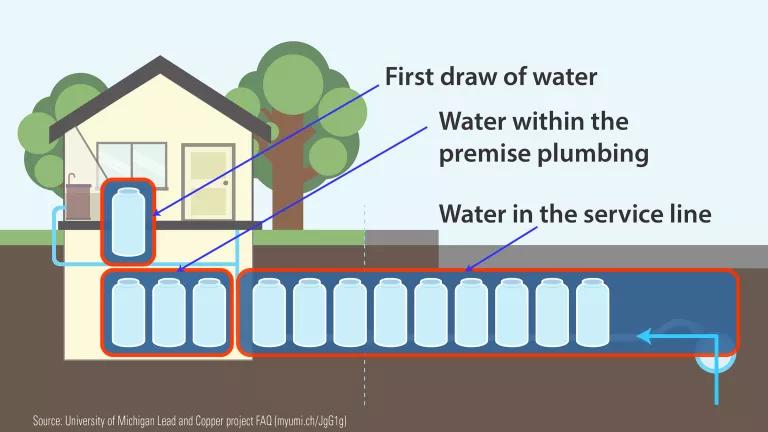Can I Use Water Sampling to Identify a Lead Service Line?
If you are trying to find out if you have a lead service line and you are comfortable with uncertainty and do not want to dig up your yard, water sampling can provide an alternative but less conclusive approach for identifying lead service lines.

The various points of water sample collection when testing for lead at a home
Graham Sustainability Institute, University of Michigan
Guest post by Elin Betanzo, Principal, Safe Water Engineering LLC
If you are trying to find out if you have a lead service line and you are comfortable with uncertainty and do not want to dig up your yard, water sampling can provide an alternative but less conclusive approach for identifying lead service lines. This means collecting a series of one-liter bottles of water from your kitchen tap so that you collect all the water that fills the plumbing between your kitchen faucet and the water main. This typically requires 10 to 15 one-liter bottles.
If these samples are collected after a minimum of 6 hours with no water use in the house, the lead results from these samples may reveal a curve characteristic of a lead service line where lead levels increase and decrease in the water that has been sitting in the lead pipe (see figure below). Lead sampling results can sometimes reveal a high lead value that comes from particulate lead, tiny flakes that have broken off of the pipe surface or interior plumbing. This can happen in homes with and without lead service lines (e.g., homes with lead solder), but it happens more frequently in homes with lead service lines.
If the lead results show a characteristic curve like the one in the figure below, the service line should be assumed to be made of lead. If the results do not show a steady increasing and decreasing curve, persistent lead—even at low levels—should be interpreted as a potential lead service line and confirmed through excavation. If the home has a partial lead service line, the lead levels may not increase as much as they would in a home with a full lead service line, and the elevated lead might be found in fewer sample bottles. An increase in lead of any magnitude indicates the potential for a lead service line.

Source: Del Total, M. A., A. Porter and M. R. Schock (2013). "Detection and evaluation of elevated lead release from service lines: A field study." Environmental Science and Technology 47(16): 9300.
If the results do not indicate detectable lead, there is still a chance that the service line is made of lead but there was unintended water use during the 6-hour stagnation period, or corrosion control treatment is highly effective. In this case, residents should consider the age of the home, history of renovations at the home, and information on other service lines on the same block to weigh whether the service line might still be made of lead. The only way to confirm the service line material is to expose the buried pipe.
Even though lead service lines are the largest source of lead in drinking water when present, lead is found throughout household plumbing in faucets, fittings, and lead solder. Water sampling results can show lead from any of these additional sources, but it is complicated to pinpoint inline sources of lead in water using sampling alone.

Safe Water Engineering
Elin Betanzo is the founder of Safe Water Engineering LLC, a small consulting firm working to improve access to safe drinking water through engineering and policy consulting building on 20 years of drinking water experience. In August of 2015, Elin played a critical role in uncovering the Flint Water Crisis by encouraging pediatrician Dr. Mona Hanna-Attisha to conduct a study that discovered elevated lead levels in children living in Flint, Michigan.




